
Squirrels in the Attic
If you have squirrels in your attic, follow these steps to remove them, effectively and humanely:
- Inspect inside your attic to confirm squirrels and identify any damage.
- With a ladder, inspect the entire exterior of the building to identify all entry holes.
- Listen to the noise. Make sure you hear several squirrels, meaning the babies grew up.
- If you hear just one squirrel, it's the mother, and she has a nest of babies in the attic.
- If you are sure the baby squirrels are grown & mobile, seal all entry holes except the main one.
- Install a one-way exclusion door or funnel on the primary entry/exit hole.
- Wait three days. When you hear no more noise, remove the door and seal the hole shut.
Below are some tips and principles, including what things not to do. The internet is full of bad advice, and many "professional" trappers employ bad techniques. Be informed!
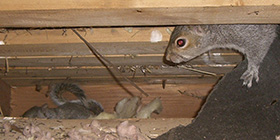
There Are Probably Babies: Squirrels typically enter an attic or other part of a building for one reason: to have a safe place in which to give birth and raise young. Males rarely enter an attic space. A pregnant female squirrel instinctively seeks out a nesting area. Our man made structures provide great shelter - warm, dry, safe from predators. Squirrels give birth twice per year, roughly in late summer and late winter. You must be aware that if you have a squirrel in the attic, there is almost surely a nest of babies. You can not simply remove the mother squirrel. If you do so, you will leave the nest of baby squirrels to starve to death. This is cruel, and the decaying bodies can cause odor problems. Wait. The nest of baby squirrels grows quickly, and by six weeks old, are nearly adult size and mobile.
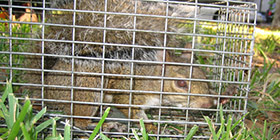
Don't Use Cage Traps: Cage traps may have names like "Havahart", and you may think that catching a squirrel alive and relocating it elsewhere is a humane approach. However, it is not. Squirrels caught in cages usually injure themselves by frantically banging against the steel cage. They often kill themselves. In addition, a squirrel can succumb to heat stroke or death by stress or exhaustion in a cage trap very quickly. If you do relocate the squirrel elsewhere, it will be in unfamiliar territory that is either unsuitable to survival, or is the territory of other squirrels, and the animal will slowly die of starvation or stress. It also puts stress on any squirrels already living in that area. Live cage trapping may seem humane, but it's usually the most cruel.
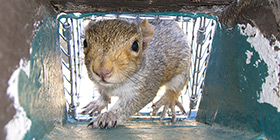
Use a One-Way Exclusion Door: This is a far better means of removing squirrels than a cage trap. When mounted on the squirrels' normal entry/exit hole, a one-way exclusion door allows the squirrel(s) inside the attic to exit, but not re-enter the building. It's a one-way exit! The squirrels are then stuck outside, and unable to get back inside. They still live in their native territory, with a higher chance of survival, and the added bonus of keeping other territorial squirrels at bay. A one-way door has the highest rate of success, since cage traps don't always work. It gets only the target squirrels, the ones in your attic, instead of catching other neighborhood squirrels. And most of all, it gets all the squirrels out at once, with less effort than repeated cage trapping.
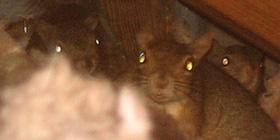
You Might Be Able to Scare Them Out: In some cases, you might be able to indimidate a female squirrel into leaving the attic space without the need to trap or use one-way doors at all. If you can address it before she gives birth, and can convince her that your attic is an unsuitable place in which to nest, she may just pick a new nesting area. Find the entry hole into your house, and smear or spray raccoon eviction fluid around and in the hole. This may intimidate her into moving on. You can also enter the attic and make your presence known, or bang on the ceiling and wall spaces in which you hear them. You can try things like a radio, vinegar or ammonia-soaked rags, or flashing lights, but these tactics have little to no demonstrated effectiveness, especially if a nest is already present.
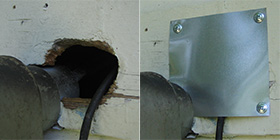
Simply Seal Them Out: At some point in the process, you will have to seal your house and make it squirrel-proof. If you've extracted all of the squirrels with a one-way door, the final step is to remove the door and seal the entry hole shut. But you can also take a risk and simply seal the holes during daylight hours, most likely morning and late afternoon, when the squirrels are naturally outside foraging for food and water. Seal all entry holes with steel screen or metal flashing reparis that are sturdy and chew-proof. This strategy is risky, because you can't be sure the squirrels are outside, you can't be sure the are all outside, and you can't be sure if there's a nest of baby squirrels, which is likely. If you seal the hole(s) and still hear noise, open the holes immediately!
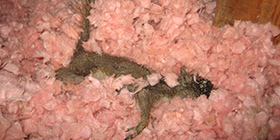
Never Use Poison: There is no registered, legal, or effective poison manufactured for the extermination of squirrels. Some people call squirrels "just rats with bushy tails". And it's true that both rats and squirrels are rodents. It's also true that the use of rodenticides is a common approach to rat control employed by pest control companies. But here's the thing: first of all, squirrels don't eat anything inside the attic, and very rarely eat any of the rat poisons sold. Second of all, the use of poison is a terrible approach to rat control. It doesn't work. It's lazy and profitable for pest control companies, who want to sign you up to a never-ending monthly contract and never lose you as a customer (thus they want to never solve the problem). Poison does not kill all the rats, and the ones it does, usually die in the house and cause a horrible odor. The attempted use of poison is doubly stupid for squirrels.
Information About Squirrels in the Attic
The most common animal to invade the attic of a house is the Eastern Gray Squirrel (Sciurus carolinensis) which lives throughout most of the United States and the west coast. These adaptable urban rodents are adept
at climbing, exploring, and chewing. They like to live in tree hollows or self-constructed nests in trees, but have found that the attics of buildings provide superior shelter. Squirrels give birth twice per year, once
in late summer, and once in late winter, and the pregnant female instinctually seeks out a safe den in which to raise her young. If you have a squirrel in the attic, it's almost certainly a female with a litter of 3-5 babies.
How do you know if you have squirrels in your attic? The most common sign is the noise. Squirrels are active during daylight hours, particularly morning and late afternoon. If you hear noise in the attic during the day, it's almost
surely squirrels. If you hear noise in the attic at night, it's more likely rats, mice, raccoons, or even flying squirrels. An inspection inside the attic can also help, if you discover squirrel feces, tracks, or nesting material.
However, you may not spot these things, because the activity might be down in the soffit, or concealed by insulation. A thorough inspection of the exterior of the home should reveal some open entry holes. The primary entry hole
will likely have some chewing marks.
It is our goal to provide complete instructions for the safe, effective, and humane removal of squirrels from buildings. In short, here is how to get rid of squirrels in the attic:
- Inspect inside the attic to confirm squirrels, and the exterior of the house, especially eaves and roof vents, to find all entry holes.
- Listen carefully. If you hear only one animal, it's a female with a nest of immobile babies. Wait a few weeks until they grow up, and are all active.
- Use metal flashing to seal all secondary entry holes. Then use screws and washers to bolt a one-way exclusion door over the primary entry/exit hole. You can purchase one or make one. Wait two days to ensure that they are all out, and you hear no more noise. If you do hear noise, remove the one-way door at once and try again in a week.
- Once they are all out, remove the door and seal the last hole. Always use steel mesh or metal flashing to prevent re-entry by chewing.
Squirrel Control Advice Articles
- How do you know if you have a squirrel in your attic?
- Will a squirrel in the attic have a nest of babies?
- Will natural repellents get a squirrel out of the attic?
- Do mothballs or ammonia repel squirrels?
- Will a bright light or high pitch sound work?
- How to keep squirrels out of your house
- How to keep squirrels away from your property
- How to get squirrels out of the chimney
- Will repellents get a squirrel out of the chimney?
- How to get squirrels out of a wall
- What if a squirrel got inside my house?
- What equipment is needed to trap a squirrel?
- Is it safe to handle a squirrel with bare hands?
- What is the best bait to trap a squirrel?
- Is it legal for me to trap a squirrel?
- What to do about a cage-shy (hard to trap) squirrel
- How to use a one-way funnel to get squirrels out
- What should I do with a squirrel after I catch it?
- Where should I relocate a trapped squirrel?
- What are some humane ways to kill a squirrel?
- About Flying Squirrel
- Should I ever poison a squirrel?
- Are squirrel feces dangerous to touch or breathe?
- What should I do if I find a nest of squirrels?
- What should I do if I find an orphaned baby squirrel?
- Should I feed a baby squirrel I found?
- Do squirrels make good pets?
- What to do about a squirrel on the roof?
- Do all squirrels have rabies?
- What diseases do squirrels carry?
- What are some of the symptoms of a sick squirrel?
- Do more squirrels live in urban areas, or wild areas?
- What is a squirrel’s natural diet?
- What is a squirrel’s mating habits?
- How to keep squirrels out of my garden
- How to keep squirrels out of my bird feeder
- Should I hire a pro, or remove squirrels myself?
- How do I know if there are baby squirrels in the attic?
- Will homeowners insurance pay for squirrel damage?
- How to find and remove a dead squirrel in a house
- What kind of damage do squirrels cause in an attic?
- How smart are squirrels?
- All About Squirrel Nests
- Do squirrels chew on electrical wires?
- Do squirrels chew on wood in or on a house?
- How well can squirrels climb and jump?
- What kind of noises and sounds do squirrels make?
- How to stop squirrels from chewing on your house
- How to identify squirrel tracks
- What does squirrel feces look like?
- Will a squirrel chew through the ceiling?
- Do squirrels attack or bite people?
- Do squirrels kill mice, rats, or birds?
- Do squirrels remember where they bury nuts?
- What do squirrels do with their tails?
- Are squirrels ever active at night?
- Information about Squirrels
- What attracts squirrels?
- How to Get Rid of Flying Squirrels
- What to do about a squirrel in the fireplace
- How do I clean squirrel feces out of my attic?
This Month's Advice: About Flying Squirrels
There are 43 species and 14 genera of flying squirrels. Some of these species are not understood well. They can make deep holes in trees and they cannot see whether it is night or day outside. The flying squirrel is not completely nocturnal, and they use their circadian clock as a reminder to awaken them during twilight.
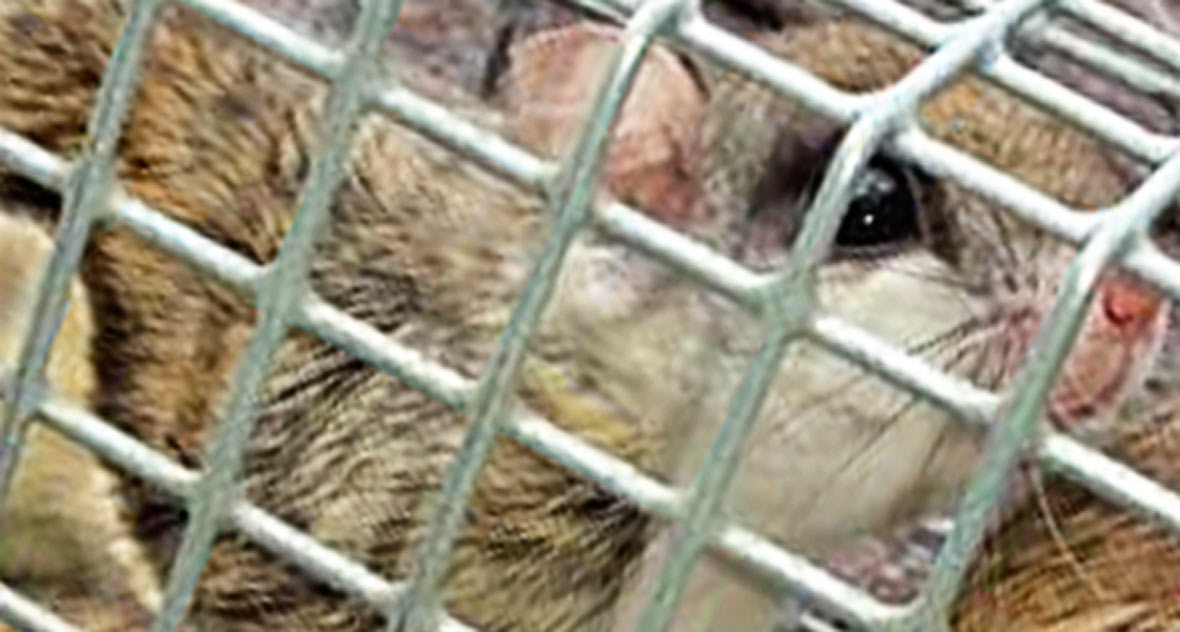
Flying squirrels are small and medium sized rodents, and they are adapted for living in arboreal life. The squirrel has a slender body and it has a bushy tail. The tail makes the flying squirrel look bigger. The squirrels have gliding membranes; they use them to fly. The giant flying squirrel can stretch its neck to reach its tail. The flying squirrel is recognized by its prominent ears and large protruding eyes. The can have fairly soft, dense fur, and they are found in many colors that can range from brownish to black to gray. The giant flying squirrel has bright colors, which include bright yellow and vivid orange.
Flying squirrels are found in the arboreal group, and they are able to make their habitats in different places like forested and wooded regions. They can live in a temperate deciduous forest and tropical rainforests. A few species live on plantations and parklands.
Flying squirrels are most of the time nocturnal, but they have different types of social systems. The flying squirrels live in pairs since they are monogamous. The flying squirrel is typically territorial, but this behavior cannot be found within the temperate species.

